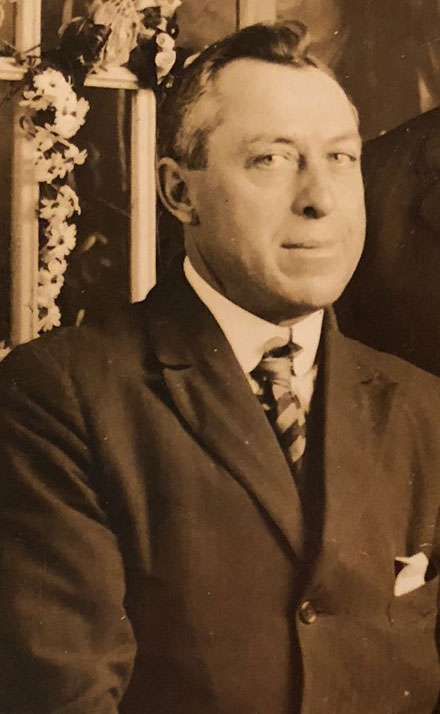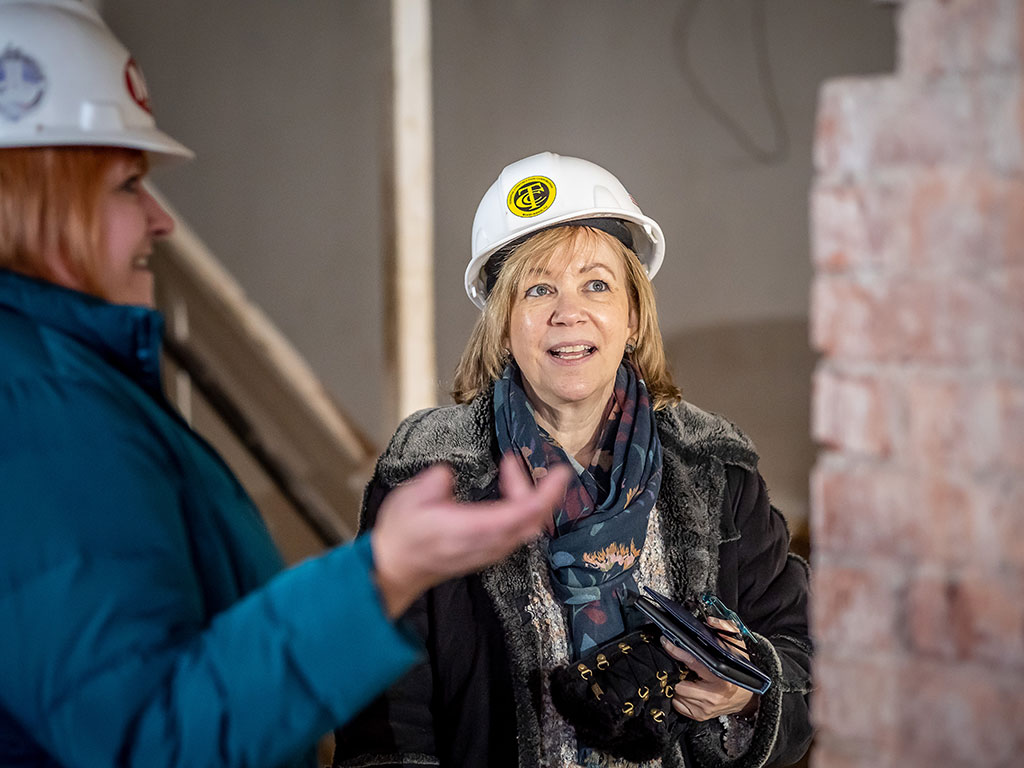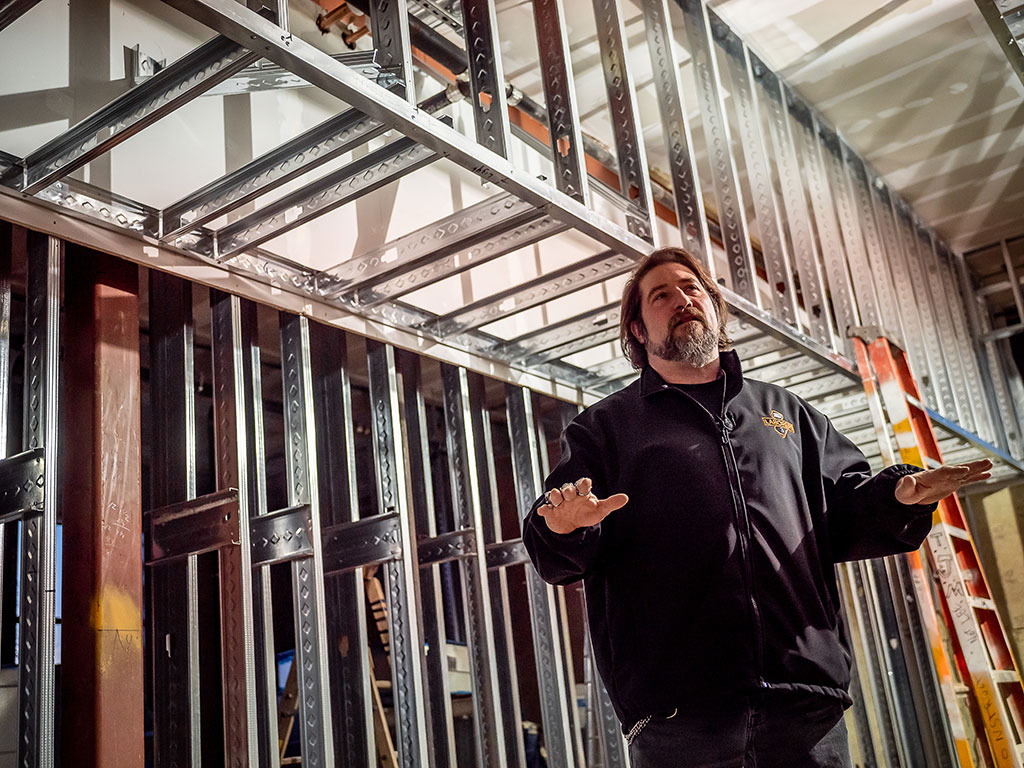
The Descendants
Families, historians look back through generations to solve the mysteries of the 112-year-old message in a bottle discovered in College Hall and left by bricklayers who built the foundation for the University
“This is to certify that this wall was built by two bricklayers from Newark, N.J., by the names of William Hanly and James Lennon, members of No. 3 of the B.M.I.U. of America.”
A message in a bottle that tumbled out of a 112-year-old wall demolished during renovations of College Hall proved an irresistible genealogical treasure hunt, leading to the descendants of one of the men.
The lives of the two bricklayers – William Hanly and James Lennon – were all but forgotten until the note’s discovery last year. With the help of family historians and a Montclair State alumna who is also an ancestry expert, family trees have uncovered some of the mysteries of the two skilled craftsmen from Newark, New Jersey.

Descendants of James Lennon now understand more about the man they knew only through a single photograph. And the fate of William Hanly is poignant and best understood through the newspaper account of his young wife’s funeral just a few months after the co-workers built and left a note in the wall.
“I think the bottle was meant to be found the way it all turned out,” says Nancy Foster, the granddaughter of James Lennon.
Message in a Bottle
The bricklayers’ note, dated July 3, 1907, and among the oldest ever discovered, piqued people’s interest around the world in finding their families.
Written in elaborate cursive script, the note was placed inside a beer bottle; the pieces of which would ultimately contribute clues to the bricklayers’ roots. Manufactured by the Consolidated Bottling Co. and made for pale ale or porter, the bottle was broken more than a century later when Robert Kanaby started tearing down the wall.
“I can imagine what they were doing the day before the Fourth of July, kicking back, having a couple of beers and deciding to write a note and put it in the wall,” says Kanaby, who found the bottle when his chipping gun hit its hiding space.
Story Goes Viral
This magazine first published a story on the discovery in the Fall/Winter 2019 issue. Spreading on social media, the story was picked up by local, national and international media outlets, sending out an SOS to long-lost family. It traveled as far as Russia and Thailand, was front-page news and viewed by millions.
Cousins, nieces and siblings connected to Lennons, Hanlys and Hanleys, after seeing the news on CNN or in People, began reaching out to each other and to the University: “Could that William Hanley be Uncle Bill?” “Is James Lennon the same man as my grandfather in this old family photo?”
Family historians shared mementos, including a photo of James T. Lennon in his 40s that set the search on the right path.
With the pieces of the puzzle coming together, Lorraine Arnold, an alumna and a genealogist, came to campus to look over the clues. As the founder of Legacy Roots, a company devoted to legal, historical, genealogical and biographical research, the Jurisprudence degree she earned from Montclair State in 2011 helped her launch a career finding missing evidence and people who have gone incognito.
This College Hall discovery made for a good mystery, she says. “When you have very little information, that’s what makes the plot intriguing and interesting.” And with a 112-year-old note signed by men with common last names, “we have very little information to go by.”
But that information turned out to be enough. “By moving beyond face value, gleaning and researching the facts that are listed, multiple doors open that ultimately bring the story to life,” she explains.
Census Data Provides a Clue
The bottle was found during the renovation of a campus centerpiece – an original mission-styled building erected to educate teachers.
Concealed in a space within an 18-inch thick wall, it would have been reasonable to believe the note would remain hidden for a long time, if not forever.
“I think the bottle was meant to be found the way it all turned out...This opened a door for me.”
“Back then, blood, sweat and tears went into building this wall. When we found the bottle, a little bit of tears were shed,” Kanaby says.
Historians and family members gathered primary sources, including newspaper articles, birth and death certificates, directory and U.S. Census records, which point to James T. Lennon, the youngest child of a bricklayer named Thomas, as the most likely Lennon to have worked on College Hall in 1907.
Genealogy is not an exact science, but researchers can make reasonable conclusions. According to Arnold: “Sometimes you have to take a leap of faith based on the overwhelming documentation that you have available to you.”
Connecting the Dots
The U.S. Census provided leads, beginning in 1900 with the occupation of James T. Lennon of Newark listed as mason. State birth records show that in March 1914, James, then 43, and his wife, Otillia, 39, had their only child, a daughter, Eileen.
Eileen married Charles Richard Moore in 1939. A Moore family historian shared a meticulously organized binder of old records and photos she has researched and collected through the years tracing the roots not only of the Moores but also the families they married.

Eileen and Charles had two children who survived infancy. Their daughter, Nancy Foster, is now a teacher who lives in Florida. Their son, Jon, died in 2005. An indexed section of family keepsakes includes a photo of James Lennon in his 40s, wearing formal attire.
“This opened a door for me,” says Foster, noting the remarkable connection of her teaching career and her grandfather’s role in building one of New Jersey’s early teachers’ colleges.
James died on October 27, 1942, two years before his granddaughter was born, and is buried in an unmarked grave at Holy Sepulcher Cemetery in East Orange. Neither Foster’s mother nor grandmother passed down family stories, she says, so learning about his connection to Montclair State gave her a window into his life she didn’t previously have.
Lennon’s pride of ownership in a job well done resonates with his great-granddaughter Ali Young, a retired Air Force flight chief who lives in Alaska. “I now know where I get my work ethic from,” she says.
Union Bonds
Looking deeper into the life of William P. Hanley reveals strong ties between the two bricklayers.
“The camaraderie between union members and laborers, bricklayers, masons, carpenters is very tight,” Kanaby says. “Once you make a bond with someone, it’s almost a bond for life.”

Hanley and Hanly are common names, often interchanged through the generations. And public records tell a story of a mason by the name of William Hanley, whose wife Mary O’Mara died at age 29. A November 20, 1907, Newark Evening Star article about her death shows she died suddenly and notes that James Lennon was a pallbearer. “Last Saturday she apparently was in the best of health. In the morning, she washed and dressed her children, whose ages are one to ten years, and sent them off to play. In the afternoon, she complained of pains in the region of the heart.”
Further tracing Hanley after his wife’s death proved difficult. The 1910 Census shows their daughters living in orphanages and a son, William Jr., being raised by a widow. The date of the bricklayer’s death remains unknown.

Renovation and Dedication
College Hall opened in September 1908 as the New Jersey State Normal School at Montclair. Over the decades, generations of students have passed through its doors as the school itself has grown into Montclair State, now New Jersey’s second-largest university.
“We knew we had something special with this building early in its renovation,” says Shawn Connolly, vice president for University Facilities.
Workers have also found notes on the attic walls from another era – wishing students a safe return from World War II – as well as a 1940s business card from a representative for the craftworkers labor union in Montclair.
The University is preparing an exhibit for the artifacts and a ceremony to honor the bricklayers’ families when College Hall reopens.
“We’re not sure if the masons who placed the message in the bottle ever thought it would be found. But it’s a time capsule of sorts, giving us a glimpse of the men who constructed the building,” Connolly says. “Now they and their families will forever be a part of our history.”
Research contributed by Lorraine Arnold; James Lennon family tree and photos were shared by his granddaughter’s paternal cousin, the former Phyllis Moore.
Photography by Mike Peters
Video by Christodoulos Apostolou.